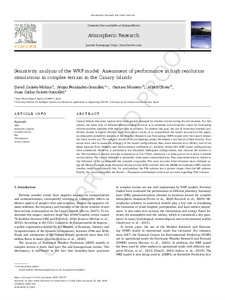Por favor, use este identificador para citar o enlazar este ítem:
http://hdl.handle.net/20.500.11765/12318
Sensitivity analysis of the WRF model: Assessment of performance in high resolution simulations in complex terrain in the Canary Islands
| Título : | Sensitivity analysis of the WRF model: Assessment of performance in high resolution simulations in complex terrain in the Canary Islands |
| Autor : | Suárez Molina, David






|
| Palabras clave : | WRF; Sensitivity analysis; Complex terrain; Microphysics; Planetary boundary layer; Numerical weather prediction; High resolution simulations |
| Fecha de publicación : | 2021 |
| Editor: | Elsevier |
| Citación : | Atmospheric Research. 2021, 247, 105157 |
| Versión del editor: | https://dx.doi.org/10.1016/j.atmosres.2020.105157 |
| Resumen : | Canary Islands and other regions have been greatly damaged by weather events during the last decades. For this reason, the main duty of National Meteorological Services is to minimize socio-economic losses by forecasting adverse weather episodes with enough time in advance. To achieve this goal, the use of numerical weather prediction models is highly relevant. And, even more crucial, is to comprehend the model accuracy. In this paper, an exhaustive sensitivity analysis of the Weather Research and Forecasting (WRF) model over the Canary Islands has been carried out. The complex terrain of the archipelago makes the islands a test bench of high interest. Four scores were used to assess the accuracy of the model configurations: Bias, mean absolute error (MAE), root of the Mean Squared Error (RMSE), and the correlation coefficient (r). Initially, twenty-five WRF model configurations were considered. However, a preliminary test discarded inadequate configurations, and reduced the number to six. The variables of interest were air temperature at 2 m (T2m), maximum 1-h wind gust at 10 m and 3-h rainfall accumulation. The results indicated a systematic wind speed underestimation. This underestimation is related to the influence of the location and the complex orography. The most accurate wind forecasts were obtained using the Mellor-Yamada-Janjic Planetary Boudary Layer (PBL) scheme with the WSM6 microphysics (MP) scheme. Another major conclusion is that, for precipitation, the PBL scheme has a greater impact than the MP scheme. Finally, the results show that the Boulac – Thompson combination is the most accurate regarding T2m forecast. |
| Patrocinador: | Observational data are provided by the State Meteorological Agency of Spain (AEMET). The authors are grateful to the Weather Forecast Research Team for developing “Verif” software. Special thanks go to the SAFEFLIGHT (CGL2016-78702-C2-1-R and CGL2016-78702-C2-2-R) and UE ERA-NET Plus NEWA (PCIN2016-080) projects. |
| URI : | http://hdl.handle.net/20.500.11765/12318 |
| ISSN : | 0169-8095 |
| Colecciones: | Artículos científicos 2019-2022 |
Ficheros en este ítem:
| Fichero | Descripción | Tamaño | Formato | ||
|---|---|---|---|---|---|
| Atmos_105157_WRF.pdf | 3,52 MB | Adobe PDF |  Visualizar/Abrir |
Los ítems de Arcimis están protegidos por una Licencia Creative Commons, salvo que se indique lo contrario.





